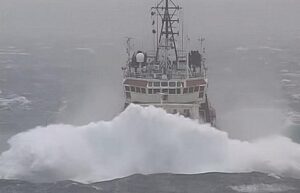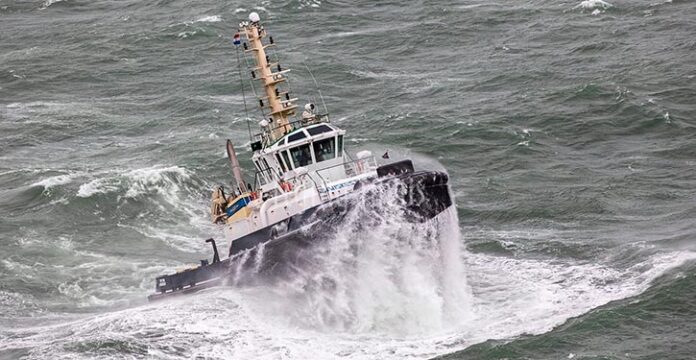We think this story written by M.Carr is so worthwhile not to hide but to share:
It Never Ends: A Month of Towing in the Bering Sea
The unnamed crew member writes about his physical strain (ongoing continuous strong wind with lots of gale, less sleep, less communication, meals you can’t enjoy, etc) when he was on board a container barge towing tug:
Editor’s note: Yes, I can proof this! Crossing the North Atlantic during winter season is close to this at the Bering Sea and really no fun. It worns you down…
He could not take it anymore. It was all too much. The constant gale force winds, the paranoid Master, the degenerate 2ndmate, the dysfunctional cook, and an engineer who hid from everyone. All this were destroying his mental health.
A week ago, or maybe longer, he could not remember now, he had e-mailed his wife from the tug’s bridge computer and asked her to call the company office in Seattle.
“Ask for Janice and get me off of here…as soon as can. Please,” he wrote. He felt guilty asking his wife to intervene, but he also felt his inner strength and resolve rapidly draining away. He just did not have the fortitude to engage the home office.
Also, he thought, he did not want the tug’s skipper and crew to know he was begging to get off. He was worn out, mentally and physically. He had endured hardship before, but this was different. This time it was insidious, persistent and had relentlessly torn him down since he had embarked on the boat a month earlier in Nome, Alaska.
Prudhoe Bay* was a 147-ton, 90-foot tug built originally for work in Prudhoe Bay Alaska. But now she was hauling barges loaded with containers from King Cove in the Aleutian Islands, up the Yukon River, and to Nome. Built for “coastwise” trade, with a flat bottom and 10 ft. draft, the Prudhoe Bay was now being used to drag barges across the open expanse of the Bering Sea.

From King Cove to Nome is 800 miles of open and exposed ocean. Every low pressure system coming off Siberia screams across the Bering Sea, bringing days and weeks of constant gales, clouds, rain, and miserable depressing weather. There are few places on earth as gray and demoralizing as the Bering Sea. It can make you lose your mind. There is no escape, no hope that by the end of the day – or week or month – conditions will have changed.
When Prudhoe Bay departed King Cove a month ago, or maybe it was more than a month, it’s too difficult to add up the endless days, they were towing a 400-foot barge loaded with containers stacked four high. A huge tow by any standard, with so much windage. It was almost comical to see the 90-foot Prudhoe Bay towing this monster of a barge.
“Who dreams up these operations,” he asked the tug’s skipper.
“They don’t fucking think about anything in Seattle,” said the skipper.
“They bid on jobs to keep their tugs busy and making money. If they thought we could tow a fucking iceberg to the lower 48, they would bid the job.”
“Great,” he thought. “What a mess. This is not what the Personnel Office told me I would be doing. I am so, so, so stupid.”
When Prudhoe Bay departed King Cove their first challenge was getting through False Pass, the safest and most protected passage through the Aleutians. False Pass comes by its name because it does not appear to actually provide a passage through the Aleutian Islands, but it does.
In some ways the passage is awesome in its beauty, with high mountains and rocky crags lining the passage, which is a mere few hundred yards wide in places. Rain, fog and clouds obscure the mountaintops, and winds roll down the cliffs. If you were on a cruise ship it might be impressive and elicit “oohs” and “ahhs”. But on a 90 ft. underpowered tug pulling an uncooperative and mercurial 400-foot loaded barge it is just unceasing stress and concern.
Every mariner who tows knows about catenary. Catenary is that dip in the tow cable, which prevents the cable from jerking and breaking. Catenary allows a tow to be “in-step” with the towing vessel, ensuring both the tug and tow rise and fall in a seaway together. In deep open water, where the ocean bottom is miles away, the depth of the catenary is of little concern. But in shallow water, if the tow cable dips to far below the surface it will drag on bottom. This is dangerous because a tow cable dragging on the bottom will stop a tug and allow the tow to overrun it, causing the tug to capsize and sink.
Unlike the Pacific Ocean, the Bering Sea is shallow, in some places as shallow as 60 ft. Constant attention to a tow cable’s catenary is essential, and because of shifting winds and erratic seas, the length of a tow cable must be adjusted often. Sometimes several times during a 4-hour watch.
On the Prudhoe Bay, the tow cable is adjusted at the towing winch on the stern. Since only one person is on watch at a time, the mate must leave the pilothouse, with the tug on autopilot, and walk to the stern to engage the towing winch to let out or pull in tow cable.
How much to pull in or let out? It’s an educated guess. Let some out, pull some in, then go back to the pilothouse. Check your speed over the ground, check the depth, check the tow. Is the barge riding smoothly behind you, or is it yawing or pounding into the waves? Is the tow cable jerking or is it staying in the water? Tough enough during the day to accomplish this task, almost impossible at night. This task is always a challenge when you are rested, but after weeks of towing in gale force weather you frequently cannot remember what you were doing.
“Was I pulling in tow cable, or letting out cable?” Fatigue. Constant, unrelenting fatigue.
Earlier in the month, Prudhoe Bay had sat for over a week on the east side of St Mathews Island. They sat in the Island’s lee as gale and storm force winds blew across the Bering Sea. St Mathews Island sits in the middle of the Bering Sea, hundreds of miles from nowhere. There is no escape, no lull, no pause, no reprieve.
Anchor watches were 6 on and 6 off. For 6 hours you sat in the pilothouse, by yourself, listening to wind howl and the rain pound on the windows. You watched the barges “blip” on the radar screen, a few hundred yards away. Anchoring was not really anchoring, you let out hundreds of feet of tow cable and made a circle in shallow water. The tow cable lies on the bottom and acts as an anchor for both the barge and tug. Day after day, you sit. Generators running, engines on standby, mind numbing. There is little conversation or human interaction. Your watch relief shows up, looks around, asks if anything has changed, and then says, “I got it.” Off you go to your bunk, praying that space aliens will abduct you before you have to wake and go back to the bridge.
When winds finally subsided, the tow cable was reeled in and the Prudhoe Bay resumed her slow chug-chug-chug towards Nome. Speed over the ground rarely exceeded 7 knots – slow jog or easy bike ride on land. At 7 knots, you cover 168 miles a day. You don’t want to look at the chart, since it seems like you will never arrive at your destination. Chug-chug-chug. The Prudhoe Bay is a noisy tug. There is no escape from the weather or machinery.
He finally tells the skipper that he has requested to get off when they arrive in Nome, since he knows Janice from the home office will, hopefully, soon notify the skipper that a relief is on the way.
“Why do you want to get off?” asks the skipper, more concerned about whether the request has something to do with him than anything else.
“I just can’t do this anymore,” he replies. There is no attempt to make an excuse, or invoke some lame excuse, or blame anyone. “I just can’t do this,” he says again. “It’s just too much.”
“Yeah, I get that, this isn’t for everyone,” says the skipper. “It’s a real bitch, in fact, it really sucks. I am thinking of retiring myself. No-one wants to do this run.”
He feels a relief having told the skipper, and prays his relief is on the dock in Nome when they arrive. A week later, Prudhoe Bay and her 400-foot barge pull into Nome and moor along the harbor’s seawall. He looks out and sees his relief standing there, with his sea bag, ready to board. They shake hands, exchange words and advice, and then he walks up the muddy wet pier with his bag over his shoulder. He does not look back, and his pace increases the further he gets from the tug.
*Tug name changed to protect identities.




